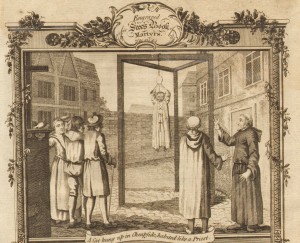 According to John Stow, the English historian and antiquarian, on this day in 1554 a cat dressed as a priest, a symbol of Catholicism, was found hanged on the gallows in Cheapside.
According to John Stow, the English historian and antiquarian, on this day in 1554 a cat dressed as a priest, a symbol of Catholicism, was found hanged on the gallows in Cheapside.
Here is Stowe’s account:
“The same 8. of April, being then Sunday, a cat with hir head shorn and the likenes of a vestment cast ouer hir, with hir fore feet tied togither, and a round peece of paper like a singing cake [consecrated wafer] betwirt them, was hanged on a gallowes in Cheape, neere to the crosse, in the parish of S. Mathew, which cat being taken downe, was caried to the Bish. of London, and he caused the same to be shewed at Pauls crosse, by the preacher D. Pendleton.”1
As Julie Crawford points out in Marvelous Protestantism: Monstrous Births in Post-Reformation England, “the motivations behind the hanging were undoubtedly contempt for Catholic or popish garments and those who wore them, and the desire to make a spectacular comment on the contemporaneous controversy over the symbolic or mystical nature of the communion ‘wafer’ (here rendered as a flat, inanimate piece of paper in clear representation of the cat killer’s Protestant views).”2
Of course, 1554 was the second year of Mary I’s reign and Parliament had already passed the First Statute of Repeal which had nullified the religious legisation passed in Edward VI’s reign and beginning the restoration of the English church to Rome. The hanging of the cat was an act of rebellion and needed dealing with. In martyrologist John Foxe’s account of the hanging, he mentions Mary’s reaction to the event:
“The 8th of April there was a cat hanged upon a gallows at the cross in Cheapside, apparelled like a priest ready to say mass, with a shaven crown: Her two fore-feet were tied over her head, with a round paper, like a wafer-cake, put between them; whereon arose great evil will against the city of London. For the queen and the bishops were very angry; and the same afternoon there was a proclamation issued, that whosoever could bring forth the party that did hang up the cat, should have twenty nobles, which was afterward increased to twenty marks; but none could or would earn it.”3
Notes and Sources
- Stowe, John. Annales of England to 1603, p1054. This can be read online at https://openlibrary.org/books/OL24989234M/Annals_of_England_to_1603
- Crawford, Julie (2011) Marvelous Protestantism: Monstrous Births in Post-Reformation England, John Hopkins University Press, p34.
- Foxe, John (1830) Fox’s Book of Martyrs; Or, The Acts and Monuments of the Christian Church, Volume I, revised and improved by the Reverend John Malham, p257.
Another account of the hanged cat appears in The Diary of Henry Machyn Citizen and Merchant-Taylor of London (1550-1563). Originally published by Camden Society, London, 1848 – see http://www.british-history.ac.uk/camden-record-soc/vol42/pp50-66.
Image: Etching taken from Foxes Book of Martyrs.